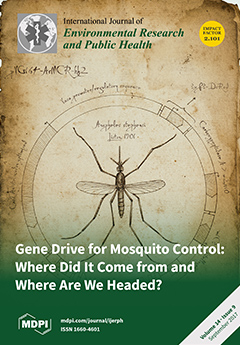Hot spring water may harbour emerging waterborne opportunistic pathogens that can cause infections in humans. We have investigated the diversity and antimicrobial resistance of culturable emerging and opportunistic bacterial pathogens, in water and sediment of hot springs located in Limpopo, South Africa. Aerobic
[...] Read more.
Hot spring water may harbour emerging waterborne opportunistic pathogens that can cause infections in humans. We have investigated the diversity and antimicrobial resistance of culturable emerging and opportunistic bacterial pathogens, in water and sediment of hot springs located in Limpopo, South Africa. Aerobic bacteria were cultured and identified using 16S ribosomal DNA (rDNA) gene sequencing. The presence of
Legionella spp. was investigated using real-time polymerase chain reaction. Isolates were tested for resistance to ten antibiotics representing six different classes: β-lactam (carbenicillin), aminoglycosides (gentamycin, kanamycin, streptomycin), tetracycline, amphenicols (chloramphenicol, ceftriaxone), sulphonamides (co-trimoxazole) and quinolones (nalidixic acid, norfloxacin). Gram-positive
Kocuria sp. and
Arthrobacter sp. and gram-negative
Cupriavidus sp.,
Ralstonia sp.,
Cronobacter sp.,
Tepidimonas sp.,
Hafnia sp. and
Sphingomonas sp. were isolated, all recognised as emerging food-borne pathogens.
Legionella spp. was not detected throughout the study. Isolates of
Kocuria,
Arthrobacter and
Hafnia and an unknown species of the class Gammaproteobacteria were resistant to two antibiotics in different combinations of carbenicillin, ceftriaxone, nalidixic acid and chloramphenicol.
Cronobacter sp. was sensitive to all ten antibiotics. This study suggests that hot springs are potential reservoirs for emerging opportunistic pathogens, including multiple antibiotic resistant strains, and highlights the presence of unknown populations of emerging and potential waterborne opportunistic pathogens in the environment.
Full article





